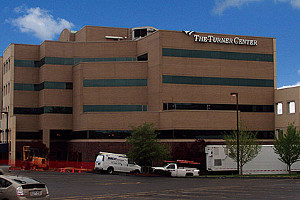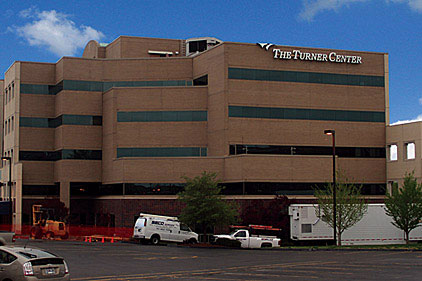 A multi-function health services facility in Springfield, MO is a showcase for sophisticated air quality management. The Turner Center is a unit of the CoxHealth system and is part of the Cox South health care campus in south Springfield. Building functions include urgent care, pediatric and adult outpatient services, a pharmacy, and numerous medical provider offices. The building was completed in the early 1980s. Due to the need for additional space and the building’s changing functions, improvements in the building’s mechanical plant were needed and these improvements resulted in a building mechanical system that is not only effective, but ultimately much more efficient.
A multi-function health services facility in Springfield, MO is a showcase for sophisticated air quality management. The Turner Center is a unit of the CoxHealth system and is part of the Cox South health care campus in south Springfield. Building functions include urgent care, pediatric and adult outpatient services, a pharmacy, and numerous medical provider offices. The building was completed in the early 1980s. Due to the need for additional space and the building’s changing functions, improvements in the building’s mechanical plant were needed and these improvements resulted in a building mechanical system that is not only effective, but ultimately much more efficient.
NEEDED SOMETHING SPECIAL
To better serve the variety of health care functions in the building, the CoxHealth administration wanted to improve ventilation rates and achieve better control over building humidity levels. They also wanted a system with high operating efficiency — something that doesn’t always go hand-in-hand with high ventilation rates. The Governair Series WF AHU with energy recovery and Fanwall Technology® was a perfect solution.
The original plant used a water cooled chiller system and penthouse air handler with VAV distribution. With the facility additions and the need for improved IAQ, CoxHealth approached Shannon McCall, lead engineer with Telios Engineering of Dallas, looking for help with a redesign. McCall contacted local design/build contractor Springfield Engineering Company to work with him on the project. The original design had building air recirculation and mixing with a minimum outside air setpoint. At the time, the existing facility was also struggling to maintain desired humidity levels. The new design used 100% outside air for maximum ventilation. This required a whole new approach.
CAPTURING ENERGY FROM EXHAUST AIR
The system selected was a Governair custom air handler using an ERV approach. This unit was installed in line with the outside air intake of the existing air handler. This concept uses energy recovery wheels to condition incoming outdoor air, recovering the energy from the building exhaust. ERV is an energy recovery process that exchanges the energy contained in normally exhausted building space air and uses it to treat incoming ventilation air. During warm seasons, the system pre-cools and dehumidifies, and in the cooler seasons, it humidifies and pre-heats the supply airstream before entering the AHU.
The benefit of using energy recovery is the ability to meet rigorous ventilation and energy standards while improving indoor air quality and minimizing the need to add heating or cooling plant capacity.
McCall explains that the ERV was selected both to improve the air change rates for the building, and to compensate for a low existing chiller tonnage.
“Previously, the building was struggling to hold temperature in the summer, but the ERV is supplementing the chillers and the building is now holding at a comfortable temperature.” For the Turner Center project, the three energy recovery wheels are 10.6 feet in diameter and are installed side by side along the width of the unit. Under summer design conditions, incoming outdoor air at 98°F/77° db/wb is precooled to 84°/69°. Under winter design conditions, outdoor air at -4°/ -4° db/wb is pre-heated to 42°/41°. Summer wheel effectiveness is 66% and winter effectiveness is 71%.
These summer and winter effective values greatly reduce the amount of energy required from the chilled water and heating systems, thus resulting in noticeably lower energy requirements. Decreasing the entering coil conditions from 98°/77° to 84°/69° takes a major load off of the water coils during the peak operating hours in the summer and allows for a relatively fast return on the initial investment of this project while still delivering 100% outside air to the occupants. The wheels rotate at 20 rpm, each turned by a 0.75 hp electric motor. The face velocity of air across the wheel is 866 ft/min on the supply side, and 740 ft/min on the return side. The ventilation air is pre-filtered before going through the energy wheels to help increase heat transfer by maintaining a clean wheel. Final conditioning of treated supply air including heating, cooling, and final filtration is accomplished in the existing air handler. The performance of the total energy wheels is AHRI Certified™.
CHALLENGING SCHEDULE
According to Stokes, delivery of the unit required planning. “With two very large over-sized semi-loads, there was a lot of coordination required from the hospital and security staffs.”
Springfield Engineering Company worked with Aaron Fields of Fields Mechanical Systems, Inc., the local Governair representative, in designing the system and coordinating delivery. Fields points out that the project allowed CoxHealth to continue to use the existing air handler, with only a brief system outage while the new package was installed.
“We had just one day to set the unit sections on the rooftop,” Fields says. “Once the unit was set, we waited until the following weekend to tie the unit into the penthouse and bring it on line.” He says that Stokes coordinated the unit installation and the startup process. He notes, “The facility was operating within a few hours after tying in the duct and electrical.”
CUSTOMER SATISFACTION
Fields emphasizes that the drivers for the project were maintaining air quality while meeting ventilation rates, and maintaining operating efficiency. “Since the installation, zero complaints have been logged from the facility maintenance staff,” he said.
Stokes adds, “I believe that CoxHealth is satisfied with the purpose and installation of the ERV unit.”
Gary Whittenberg from CoxHealth states, “Since this unit has been installed, we’ve not had one complaint about odor or any complaints about lack of cooling. The system recovers enough energy to supplement the existing system as well as providing 100% fresh air to the facility.”



